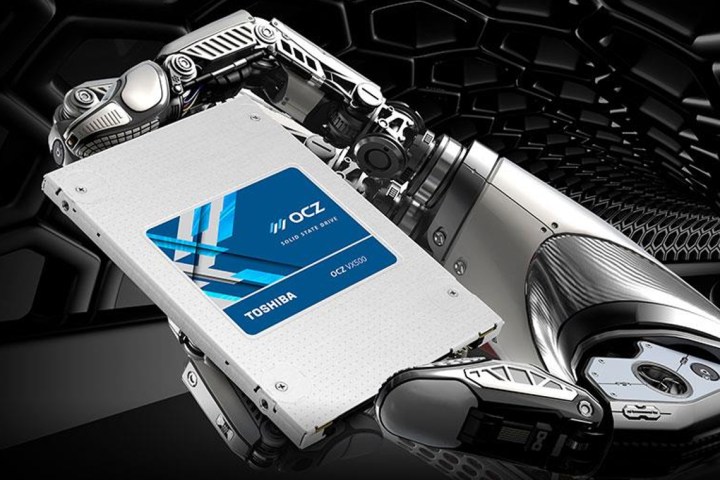
The new OCZ VX500 series arrives in four capacities: 128GB, 256GB, 512GB, and 1024GB. They’re based on Toshiba’s latest multi-cell NAND flash created with 15nm process technology, and rely on Toshiba’s in-house NAND flash TC358790 controller, which enables sequential read speeds of 550MB per second across the board and sequential write speeds ranging from 485MB per second to 515MB per second. All four models have a max power draw of only 3.4 watts.
“The Toshiba OCZ VX500 SSD series delivers endurance ratings of 74 to 592 terabytes written (TBW), making it suitable for write-intensive applications such as content creation, revolving media/game storage, or as a scratch disk,” the company said on Tuesday. “The Toshiba OCZ VX500 series is designed to thrive in mixed workload environments representative of mainstream users who need increased performance to take their everyday computing to the next level.”
The new OCZ SSDs connect via a SATA 3 (6Gb per second) interface, the same connector used by a standard hard drive. They also measure just 7mm in height, making them a perfect fit for notebooks, and require an adapter to fit within a standard desktop drive cage. They even come packed with Acronis True Image 2016 cloning software, enabling customers to make a copy of their current OS/software configuration and transfer it all to the new SSD prior to swapping out the storage.
Anandtech points out that the TC358790 controller includes a pad on its printed circuit board for a local DRAM package, and the 1024GB model takes advantage of this by including a 256MB Micron DRAM chip. This is used for NAND mapping tables to improve the drive’s overall performance, but its use means the drive consumes more power in the slumber state. That said, its idle power state is 260 milliwatts while the other three models have an idle power state of 125 milliwatts.
Toshiba considers its new drives to be “high endurance” SSDs, with the 128GB model capable of thrashing around 40GB of data per day, and the 1024GB model handling 324GB of data per day. They have a lifespan of around 1.5 million hours, and support Self-Monitoring, Analysis and Reporting Technology (SMART), as well as TRIM and Time Garbage Collection SSD clean-up technologies.
“Delivering over 3X the endurance of TLC-based SSDs, the Toshiba OCZ VX500 SSD series ensures users who need increased product longevity aren’t neglected in the wake of a value-oriented market,” said Alex Mei, VP of marketing and general manager of Etail/Retail SSDs at Toshiba America Electronic Components, Inc.
The new OCZ VX500 SSDs will become available to purchase next week with prices ranging from $64 to $337. A list of specs can be found in the chart below.
| 128GB | 256GB | 512GB | 1024GB | |
| Sequential Read | 550MB/s | 550MB/s | 550MB/s | 550MB/s |
| Sequential Write | 485MB/s | 510MB/s | 515MB/s | 515MB/s |
| Random Read | 62,000 IOPS | 90,000 IOPS | 92,000 IOPS | 92,000 IOPS |
| Random Write | 49,000 IOPS | 58,000 IOPS | 64,000 IOPS | 65,000 IOPS |
| Idle Power | 125 milliwatts | 125 milliwatts | 125 milliwatts | 260 milliwatts |
| Max Power | 3.4 watts | 3.4 watts | 3.4 watts | 3.4 watts |
| Endurance | 74TB | 148TB | 296TB | 592TB |
| Price | $64 | $93 | $153 | $337 |


